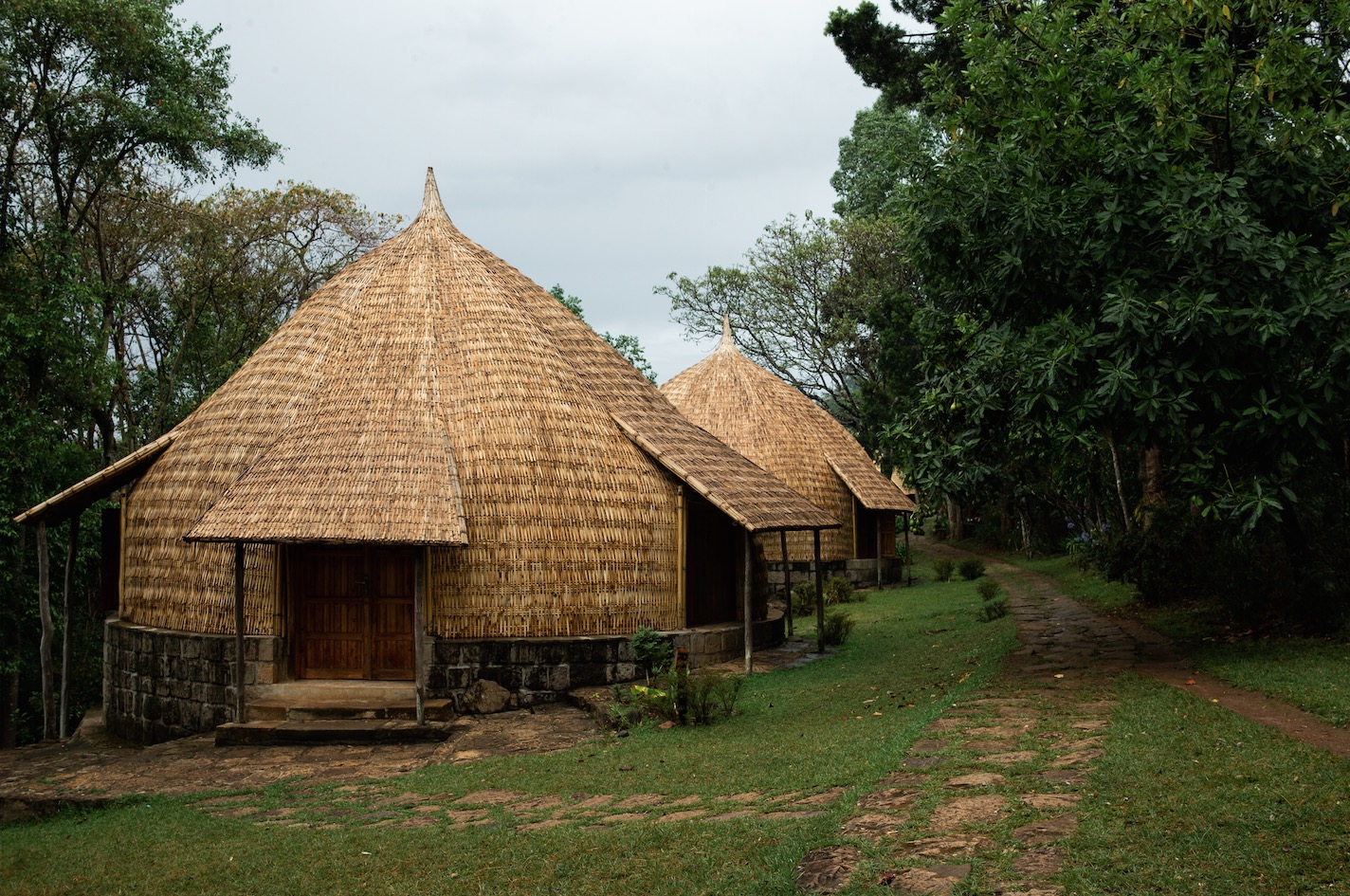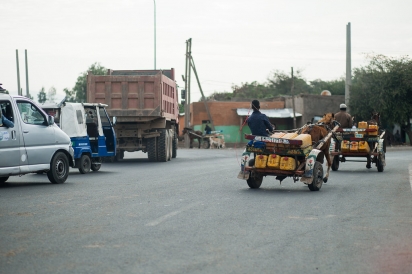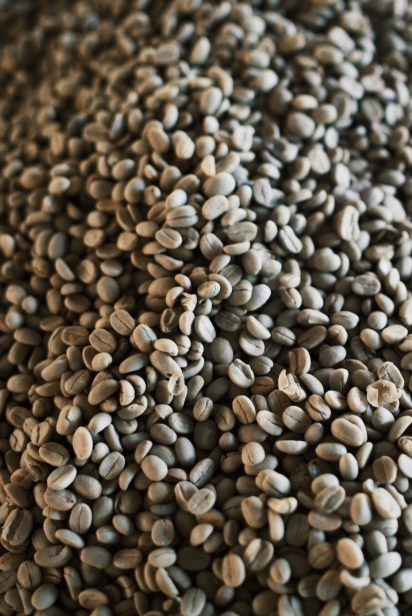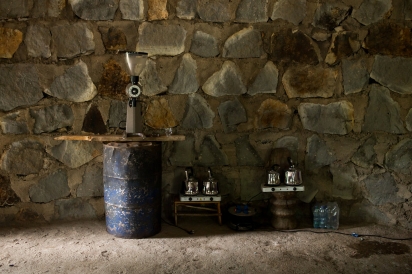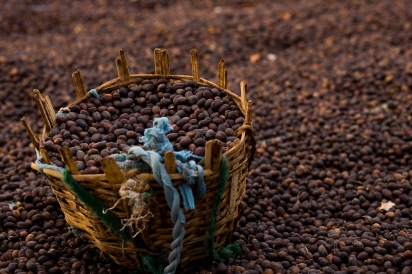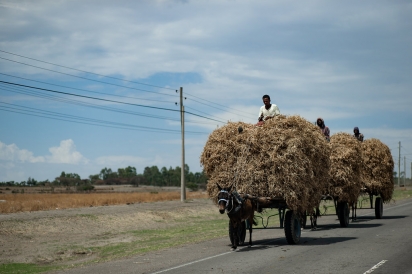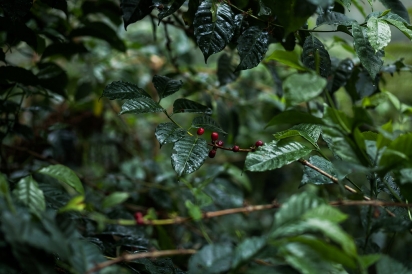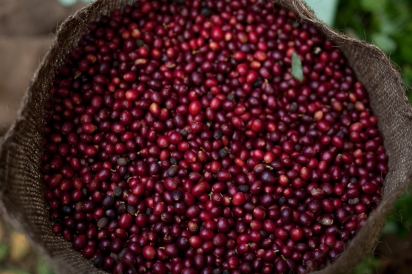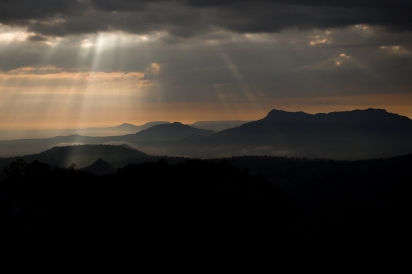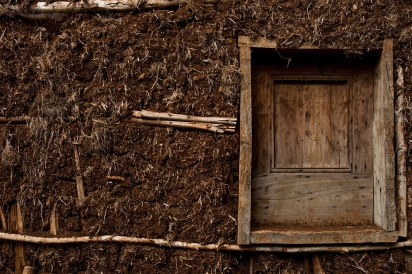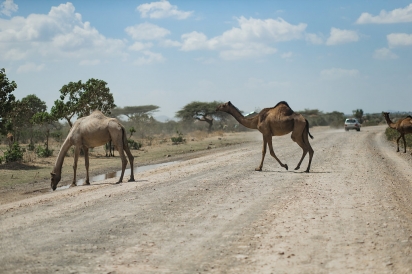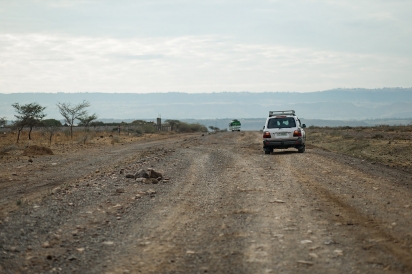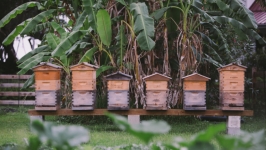On the Trail of Coffee Beans
Embers dance around the dusty corrugated-metal-enclosed courtyard of our hastily-built, simple hotel as the coal fire is fueled to life by the gusty wind of an impending thunderous downpour. Wood smoke fills the air along with the petrichor of the first rain hitting the surrounding hills after a long drought. The warm, savory-sweet smell of berbere spice, the aroma so common in Ethiopia it even scents the paper money, wafts over from the makeshift grill. A repetitious, guttural call to prayer drones from a nearby minaret interrupted sporadically by cracks of thunder and the hum of a nearby generator. The darkness in this town of no electricity is broken only by flashes of lightning and the orange glow of the fire cooking our dinner of goat tibs.
We are in the remote and rarely-visited town of Chancho in the Harar coffee region of eastern Ethiopia with our sourcing and importing partners Catalyst Coffee and Dominion Trading to meet with coffee farmers from the Tiret Coffee Producers Cooperative Association. Tiret (translated to best effort/passionate labor) is a 23-member organization led by Abebeyau Negash, a third generation coffee farmer. The cooperative, made up of friends and family members, was formed by Abebeyau in 2014 as a means to increase prosperity through the production of specialty coffee.
On the afternoon of our second day in Chancho, when we arrive at the bright-yellow gathering hall of the cooperative, many of the producing partners are already waiting. Low murmurs in the soft, round, swooshing tones of Oromifa, the most widely spoken of the 88 languages of Ethiopia, fill the hall. A fresh breeze blows through the open windows of the building as we dose our coffee beans into white, ceramic broth bowls used for cupping, the standardized method for analyzing the sensory qualities of coffee. The bowls are set on top of a chest-high wooden table at the front of the room. As a generator fires up at a far-end of the compound, the large, stainless steel one-gallon kettles sitting on electric hot plates start to hiss and pop as they slowly heat up. The motor of a coffee grinder purrs to life. As the weighed-out doses of grounds are poured from the cupping bowls into the grinder, the fruity and sweet aroma of coffee fills the room.
The wailing tones of the Adhan once again drone from the minaret through town and are carried into the hall on the wind. Once the water comes to a boil it is poured onto the coffee grounds. The coffee soaks up the water and expands. Over the next four minutes, while the coffee brews, we take turns moving down the line of bowls, smelling the steam that rises from the top of each coffee. When the brew is finished we break the crust of coffee that has formed on top of the bowl and then scrape the grounds from the cup revealing the inky, sweet and utterly complex beverage below. The coffee sampling begins. We each slowly dip a spoon in the bowl, bring it to our lips and with a strong slurp, atomize the beverage into a mist across our palate. Producers whisper to one another as they taste, smiling or looking inquisitively as if trying to pinpoint an exact flavor note. As each coffee buyer sips the samples, they each do so poker-faced, scribbling notes with pencil and paper. After we all taste the coffees and make our individual notes — either mentally or in writing — we all take our seats and discuss what was tasted. At that point the producer of each coffee, all of which were cupped blindly, is revealed.
Tegene Abebe, a tall, wiry producer with kind, rich chestnut eyes and a broad, infectious smile, has his name called for two of the dozen or so coffees on the cupping table. His two coffee farms, the largest in area of all the producers in the cooperative, are a few hours outside Chancho at roughly 7,000 feet above sea level on Mount Engule. A visit to the farms includes a bumpy Land Cruiser ride over dirt roads through the sparse, arid landscape of acacia trees, dry rivers and crumbly, jagged mountains to the base of Mount Enguele. At that point the road runs out and the farms are reachable by horseback or mule in the dry season. Getting to them in the rainy season requires an additional two to three hour trek on foot through the mud up incredibly steep terrain.
Tegene’s coffees taste of an assortment of purple fruits (plums, grapes, figs, blackberries, raisins) backed up by deep chocolate tones and a distinct note of pie-spice. This deep fruit, rich chocolate and elegantly spicy flavor profile is traditional for the best Harari coffees. Yet coffee this high in quality is a very rare exception. Today Tegene’s coffee scored 88 points on the standardized Specialty Coffee Association (SCA) scale for sensory analysis. Coffees rated this high make up the top 1% of all coffees traded in the world.
This score is amazing considering the standards set for the overall industry. But for Tegene, it’s astonishing. Just two years prior Tegene’s coffees were scoring at 76 points on the SCA scale and didn’t make the grade to participate as part of the Tiret Cooperative’s production. Increasing a coffee’s score by a few points over a couple of harvest seasons is an extremely commendable achievement. For a coffee to gain 12 points in the span of two harvests is pretty much unheard-of. Yet, Tegene pulled it off.
After the 2015/2016 harvest season Tegene, with input and help from the zonal administration and the process and quality control team from Dominion Trading and Catalyst, began focusing on many agricultural details that impact the final quality in a cup of coffee, including diverse inter-cropping and nitrogen fixation, specific variety observation and handling, along with careful harvesting processing and storage procedures. These new processes are making dramatic improvements not just in Tegene’s coffee. The refined attention to details in agricultural, harvesting and processing methods are increasing the quality and therefore the value of the coffee coming from the Tiret cooperative as a whole. Improvements in quality result in coffees that demand prices capable of turning coffee production from a business of pure hand-to-mouth existence to a sustainable business model in which producers can think about and plan for the future. The quality of coffee is tied directly to quality of life.
Next stop is Ytigessu Mulatu’s 10-hectare farm 6,500 feet above sea level on the side of Mount Engule. As we drive up the mountain, a small deer dashes in front of the Land Cruiser and the vehicle jockeys over loose rocks and warped mud trenches that form the road on the way up to the farm. We enter a small coffee forest and notice an immediate change in environment from the dry and dusty surroundings of the valley to a cooler and more humid verdure of diffused light and birdsong. The forest has some similarities to the original coffee forests of Kafa some six hours to our west, where coffee first sprang from the ground and changed the course of humanity forever.
After a 45-minute drive up the mountain we reach the bamboo and wire mesh coffee drying beds that line the front boundary of Yrigessu’s land. The coffee field sits behind two wood and mud buildings serving as living quarters and farm storage. The land is flat and the brownish-red soil springs under our feet as we walk. Yrigessu shows us his coffee growing under the dense shade of an acacia tree forest. The tall and lanky coffee shrubs reaching for light in the understory of the forest are inter-planted with a variety of subsistence and cash crops.
On the farm it is clear that Ytigessu handles his production with care. Stone walls a couple of feet tall separate the different lots of coffee. The stones were pulled by hand from the fields where they were preventing proper root development for the coffee. Each shrub has a hand cleared plate at the base to allow for better water retention in this semi-arid environment, improved nutrient retention from compost used for fertilizer and better pest management. Spacing the shrubs six feet apart on all sides offers undisturbed growth and prevents the spread of pests and disease. These methods differ greatly from the technified farms found in most other coffee farms where two to three times the number of coffee shrubs are crammed into each hectare.
After our walk through the farm we say our goodbyes and get on the road for a long trip across the Rift Valley to the renowned region of Sidama. There we will bump over more crumbling roads, meet with more farmers, cup more coffees and fall asleep nightly to the laughs of hyenas and the howling of baboons.
Hankering for a fresh cup of carefully grown coffee, sourced in Ethiopia and roasted in right here at home? Visit a Bold Bean Coffee location near you.


